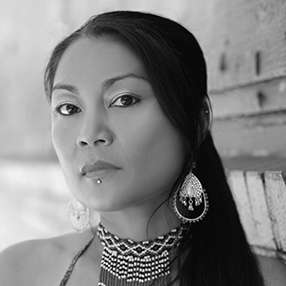Amphibious
“These people, both men and women, seem amphibious, and to be able to live on water as well as on the land, so well do they swim and dive. Five pieces of iron were thrown into the sea to them for the pleasure of seeing them exercise themselves. One of them was skillful enough to get all five of them, and in so short a time, that one can regard it as marvelous.”
—observations of indigenous Filipinos by the Dutch in 1600, from Sucesos de las Islas Filipinas, by Antonio de Morga
To be amphibious
is to breathe underwater
gills and fins
illuminated in a flash of sun
to be sirenos1
es amar el mar
es tener cuerpos de agua2
desfrutar how the sea dances
along our spines
how it fills our hair
makes us weightless
We do not care if we are seen
taken as entertainment
desnudos
observados en un acto sagrado3
Our brown bodies split the water
no para conquista
kundi para sa unyon4
Our bangka5 are extensions
of our katawan ng tubig6.
Do you know which hands carved this wood?
Mula saang mga puno?7
Whose spirits guide us to the other side?
Hindi namin kailangan ng mga mapa8
Hindi namin kailangan ng mga kumpas
Feel the immense dagat move beneath us
Can you feel it, through the thick hulls
of your conquering vessels?
We do not disrupt the harmony of things.
Can you plunge your hand into the sea
and bring up a fish?
Can you split one into two thousand pieces
so that every mouth is filled?
Can you perform such the miracles
you describe in your holy book?
Watched by mga anito9,
todos los seres vivos
nos protegen10
Bawat plankton, bawat maliit na hipon,
bawat nabubuhay na bagay11
Ser anfibias
upang maging kasuwato sa dagat12
is to breathe underwater.
1Both in Filipino and Spanish, this refers to mermen, but in Filipino folklore, while also including a version of a tantalizing creature (usually female) that leads fishermen to their deaths, sirenas/sirenos are are also engkantos or spirit-guardians of the sea. The colonial and indigenous influences in this mythology are both evident.
2“is to love the sea/is to have bodies of water”
3“naked/observed in a sacred act”
4These two lines show how Tagalog incorporated Spanish as one sees the shared words; it goes from Spanish, “not for conquest” to Tagalog “but for union”
5Bangka are Filipino outrigger boats with ancient origins that are carved from wood; it was believed that the spirit of the tree or an anito (guardian spirit) was imbued in the boat, especially through ritual consecration.
6“Bodies of water”
7“From which trees?”
8“We do not need maps / We do not need compasses”
9anito are ancestors, nature spirits, or deities in precolonial, indigenous Filipino systems, which were animistic. The word also can refer to statues and figures representing the spirits.
10“All living beings / protect us”
11“Each plankton, each tiny shrimp / each living thing”
12“To be in harmony with the sea”
Copyright © 2020 by Aimee Suzara. Originally published in Poem-a-Day on November 13, 2020, by the Academy of American Poets.
“I wrote this poem as part of a series, and a new book manuscript, exploring the encounters of Filipino natives with Spanish and other European colonists, using archival text from the sixteenth to early seventeenth century. The conquest of the Philippines in 1565 and its position as the central base of the Spanish Empire in Asia and Oceania until 1898 was concurrent with the colonial rule of many of what we call Latin American and Caribbean countries; while pure Spanish language speakers are few, a significant amount of vocabulary from Spanish was incorporated into Tagalog, resulting in a multilingualism (though the island-dwellers were likely already versed in more than one tongue; today there are at least 187). I am revisiting my indigenous Filipino bloodline and my colonial lineage in a way that both critiques the latter and recognizes its influence, imagining even what it would be like from the point of view of the ‘discovered.’ Can we consider that the natives could be fully aware of this gaze, and that resistance occurred in ways the conquistadores did not detect? I am interested in multilingualism as a mode of time travel, of expression and imagination, and of resistance.”
—Aimee Suzara

